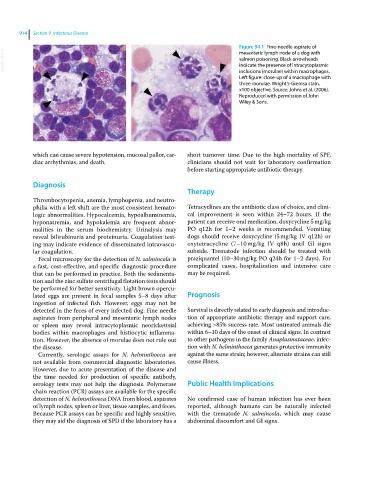Page 976 - Clinical Small Animal Internal Medicine
P. 976
914 Section 9 Infectious Disease
Figure 94.1 Fine-needle aspirate of
VetBooks.ir salmon poisoning. Black arrowheads
mesenteric lymph node of a dog with
indicate the presence of intracytoplasmic
inclusions (morulae) within macrophages.
Left figure: close-up of a macrophage with
three morulae. Wright’s-Giemsa stain,
x100 objective. Source: Johns et al. (2006).
Reproduced with permission of John
Wiley & Sons.
which can cause severe hypotension, mucosal pallor, car- short turnover time. Due to the high mortality of SPF,
diac arrhythmias, and death. clinicians should not wait for laboratory confirmation
before starting appropriate antibiotic therapy.
Diagnosis
Therapy
Thrombocytopenia, anemia, lymphopenia, and neutro-
philia with a left shift are the most consistent hemato- Tetracyclines are the antibiotic class of choice, and clini-
logic abnormalities. Hypocalcemia, hypoalbuminemia, cal improvement is seen within 24–72 hours. If the
hyponatremia, and hypokalemia are frequent abnor- patient can receive oral medication, doxycycline 5 mg/kg
malities in the serum biochemistry. Urinalysis may PO q12h for 1–2 weeks is recommended. Vomiting
reveal bilirubinuria and proteinuria. Coagulation test- dogs should receive doxycycline (5 mg/kg IV q12h) or
ing may indicate evidence of disseminated intravascu- oxytetracycline (7–10 mg/kg IV q8h) until GI signs
lar coagulation. subside. Trematode infection should be treated with
Fecal microscopy for the detection of N. salmincola is praziquantel (10–30 mg/kg PO q24h for 1–2 days). For
a fast, cost‐effective, and specific diagnostic procedure complicated cases, hospitalization and intensive care
that can be performed in practice. Both the sedimenta- may be required.
tion and the zinc sulfate centrifugal flotation tests should
be performed for better sensitivity. Light brown opercu-
lated eggs are present in fecal samples 5–8 days after Prognosis
ingestion of infected fish. However, eggs may not be
detected in the feces of every infected dog. Fine needle Survival is directly related to early diagnosis and introduc-
aspirates from peripheral and mesenteric lymph nodes tion of appropriate antibiotic therapy and support care,
or spleen may reveal intracytoplasmic neorickettsial achieving >85% success rate. Most untreated animals die
bodies within macrophages and histiocytic inflamma- within 6–10 days of the onset of clinical signs. In contrast
tion. However, the absence of morulae does not rule out to other pathogens in the family Anaplasmataceae, infec-
the disease. tion with N. helminthoeca generates protective immunity
Currently, serologic assays for N. helminthoeca are against the same strain; however, alternate strains can still
not available from commercial diagnostic laboratories. cause illness.
However, due to acute presentation of the disease and
the time needed for production of specific antibody,
serology tests may not help the diagnosis. Polymerase Public Health Implications
chain reaction (PCR) assays are available for the specific
detection of N. helminthoeca DNA from blood, aspirates No confirmed case of human infection has ever been
of lymph nodes, spleen or liver, tissue samples, and feces. reported, although humans can be naturally infected
Because PCR assays can be specific and highly sensitive, with the trematode N. salmincola, which may cause
they may aid the diagnosis of SPD if the laboratory has a abdominal discomfort and GI signs.

